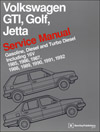Removing and Installing Drive Axles - page 11-14 (VG92)
SUSPENSION AND STEERING
5.2 Drive axles and constant velocity joints
Removing and Installing Drive Axles
1. With the vehicle on the ground, pry off the dust cap in the center of the front wheel hub and loosen, but do not remove the axle shaft nut.
WARNING
Loosen axle shaft nuts only while the car is on the ground. The leverage required to do this could topple the car from a lift or jack stand.
2. Raise the front end of the vehicle and support it securely on jack stands. Make matching marks on the control arm and ball joint so that the ball joint can be reinstalled in the same location on the control arm. Remove the three ball joint retaining bolts.
3. Clean around the inner CV joint and remove the six 8mm 12-point socket-head bolts that hold the inner CV joint to the transaxle drive flange. Support the inner end of the drive axle to prevent damage to the outer CV joint.
4. Remove the axle shaft nut and pull the drive axle out of the wheel hub. Cover the exposed inner CV joints to prevent contamination.
NOTE
A light tap with a soft-faced mallet will help dislodge a stubborn axle.
Installation is reverse of removal. Stick a new adhesive backed gasket onto the clean inner CV joint. Torque the 8mm, 12-point socket-head bolts to 45 Nm (33 ft. lb.). Torque the ball joint retaining bolts to 35 Nm (26 ft. lb.). Torque the axle shaft nut to 265 Nm (195 ft. lb.).
WARNING
Torque the axle shaft nut only while the car is on the ground. The leverage required to do this could topple the car off a lift or jack stand.
SUSPENSION AND STEERING
Before Performing any Work
Please read Cautions and Warnings before proceeding with any work on your vehicle

